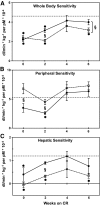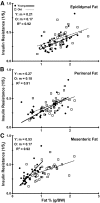Critical role of the mesenteric depot versus other intra-abdominal adipose depots in the development of insulin resistance in young rats
- PMID: 20299478
- PMCID: PMC2874702
- DOI: 10.2337/db08-0675
Critical role of the mesenteric depot versus other intra-abdominal adipose depots in the development of insulin resistance in young rats
Abstract
Objective: Age-associated insulin resistance may be caused by increased visceral adiposity and older animals appear to be more susceptible to obesity-related resistance than young animals. However, it is unclear to what extent the portally drained mesenteric fat depot influences this susceptibility.
Research design and methods: Young high-fat-fed and old obese rats were subjected to 0, 2, 4, or 6 weeks of caloric restriction. Insulin sensitivity (S(I)) was assessed by hyperinsulinemic clamp and lean body mass (LBM) and total body fat were assessed by (18)O-water administration.
Results: Six weeks of caloric restriction caused a similar reduction in body weight in young and old animals (P = 0.748) that was not due to reduced subcutaneous fat or LBM, but rather preferential loss of abdominal fat (P < 0.05). Most notably, mesenteric fat was reduced equivalently in young and old rats after 6 weeks of caloric restriction ( approximately decrease 53%; P = 0.537). Despite similar visceral fat loss, S(I) improved less in old ( increase 32.76 +/- 9.80%) than in young ( increase 82.91 +/- 12.66%) rats versus week 0. In addition, there was significantly more reversal of fat accumulation in the liver in young (% reduction: 89 +/- 2) versus old (64 +/- 5) rats (P < 0.0001). Furthermore, in young rats, S(I) changed much more rapidly for a given change in mesenteric fat versus other abdominal depots (slope = 0.53 vs. < or =0.27 kg/min/mg per % fat). CONCLUSIONS Improved S(I) during caloric restriction correlated with a preferential abdominal fat loss. This improvement was refractory in older animals, likely because of slower liberation of hepatic lipid. Furthermore, mesenteric fat was a better predictor of S(I) than other abdominal depots in young but not old rats. These results suggest a singular role for mesenteric fat to determine insulin resistance. This role may be related to delivery of lipid to liver, and associated accumulation of liver fat.
Figures





References
-
- Montague CT, O'Rahilly S: The perils of portliness: causes and consequences of visceral adiposity. Diabetes 2000; 49: 883–888 - PubMed
-
- Morimoto C, Kameda K, Tsujita T, Okuda H: Relationships between lipolysis induced by various lipolytic agents and hormone-sensitive lipase in rat fat cells. J Lipid Res 2001; 42: 120–127 - PubMed
-
- Atzmon G, Yang XM, Muzumdar R, Ma XH, Gabriely I, Barzilai N: Differential gene expression between visceral and subcutaneous fat depots. Horm Metab Res 2002; 34: 622–628 - PubMed
-
- Davidson MB, Garvey D: Studies on mechanisms of hepatic insulin resistance in cafeteria-fed rats. Am J Physiol 1993; 264: E18–E23 - PubMed
-
- Kim SP, Ellmerer M, Van Citters GW, Bergman RN: Primacy of hepatic insulin resistance in the development of the metabolic syndrome induced by an isocaloric moderate-fat diet in the dog. Diabetes 2003; 52: 2453–2460 - PubMed
Publication types
MeSH terms
Substances
Grants and funding
LinkOut - more resources
Full Text Sources
Medical

